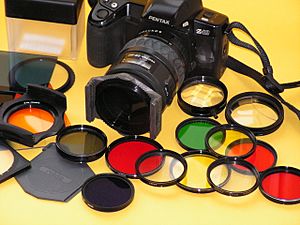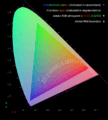Colour vision facts for kids
Colour vision is how living things and machines see and tell apart objects based on the light they give off, bounce back, or let through. Light has different wavelengths, which are like different colours.
How a person sees colours is a bit personal. Your brain makes sense of the light that enters your eye. This light reacts with special cells called cone cells. Because of this, different people might see the same object or light source in slightly different ways.
Contents
How Do We See Colours?
Your nervous system figures out colours by comparing how different cone cells in your eye react to light. These cone cells are sensitive to different parts of the visible light spectrum.
For humans, the visible spectrum goes from about 380 to 740 nanometers (nm). Most people have three types of cone cells. The range of colours and the number of cone types can be different for other animals.
Having colour vision helps you see things better. It gives you more information about what you are looking at. For example, it helps you know when fruit or vegetables are ripe. It also helps you spot animals that are hiding. Colour vision is most useful during the daytime. At night, it's more important to gather as much light as possible. This is where rod cells, another type of eye cell, work better than cones.
Different Kinds of Colour Vision

Not all animals see colours in the same way. Many animal groups can tell colours apart, but their vision works differently. For example, some mammals cannot see colours at all. Others are called dichromats; they have two types of cones. This means they cannot see ultraviolet, red, or orange light.
Scientists think that the mammals that survived the Jurassic period were small animals active mostly at night. They lived in burrows and didn't need to see many colours. After the dinosaurs died out, many mammals became active during the day. Most of them developed some form of colour vision, which is very helpful in daylight.
Primates, like humans, developed full colour vision, called trichromacy. For them, being able to tell the colour of fruit and leaves is very important for finding food. Many insects can see colours in the ultraviolet range, which humans cannot. This is why certain patterns on flowers, called honey guides, are very clear to insects in ultraviolet light.
Why Colour Vision Evolved
How animals see colours depends a lot on how they evolved. A main reason is thought to be finding food. For plant-eating primates, colour vision is key to finding the right (often young) leaves to eat. Hummingbirds often recognize specific flower types by their colours.
On the other hand, night-active mammals have less developed colour vision. This is because cones need enough light to work well. There is also evidence that ultraviolet light helps many animals, especially insects, see colours.
| Type of Vision | Number of Cone Cells | Approx. Colours Seen | Examples |
|---|---|---|---|
| Monochromacy | 1 | 100 | Marine mammals, owl monkey, Australian sea lion, some humans with achromatopsia |
| Dichromacy | 2 | 10,000 | Most land mammals (not primates), some humans with color blindness |
| Trichromacy | 3 | 10 million | Most primates (like humans and great apes), marsupials, some insects (like honeybees) |
| Tetrachromacy | 4 | 100 million | Most reptiles, amphibians, birds and insects, rarely humans |
| Pentachromacy | 5 | 10 billion | Some insects (certain butterflies), some birds (like pigeons) |
Images for kids
See also
 In Spanish: Percepción del color para niños
In Spanish: Percepción del color para niños




